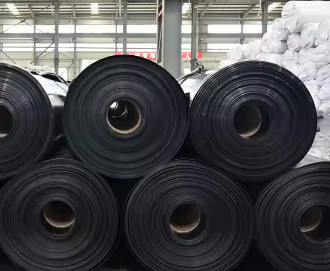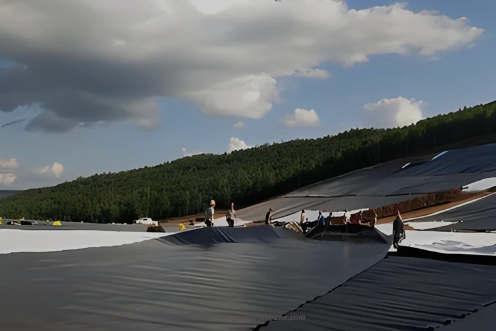- HDPE Geomembranes in the Oil and Gas Industry
- HDPE Geomembranes in Wastewater Treatment Plants
- The Versatility of HDPE Geomembranes in Industrial Applications
- HDPE Geomembranes: A Protective Layer for Aquatic Environments
- HDPE Geomembranes for Reservoir Lining: A Case Study
Manager:Alvin Wang
WhatsApp:+62 8983806051
Tel:+86 10-5797-1075
Email:steelwang@okorder.com
Address:3rd Floor, No.2 Building, No.1 Sanlihe Road
What is a HDPE geomembrane used for?
Because of its ability to resist the passage of water/vapor, chemicals and other substances, High-Density Polyethylene (HDPE) geomembrane is very versatile synthetic lining material used in different engineering applications. hdpe Geomembranes create a barrier between structures or installations and the environment which protects them from being damaged by leakages corrosion etcetera. This guide will take you through some common uses of HDPE geomembranes in civil engineering as well as their applicability across various industries.

Applicability in civil engineering
Linings for landfills:
The most common use for this type of liner is in landfill sites where they are used as containment systems that keep pollutants from leaching into surrounding soils or groundwater. One might think about how dangerous it would be if all those toxic substances were allowed to spread freely across miles upon miles of dirt! These liners act like shields – nothing gets out! Furthermore; there’s also another reason why we need such strong barriers – protection against harmful materials being released into the atmosphere.
Liners for ponds and reservoirs:
Another interesting application area involves constructing ponds, reservoirs & tanks meant for storing large volumes water or any other liquid materials. The idea behind having such facilities is usually conservation because nobody likes wasting resources especially when they’re scarce like during drought seasons but at times people just want things done differently so that everything can go smoothly without much hassle involved. Now here comes another problem; if these containers were not properly sealed then what will happen? That’s right – water will start seeping through cracks which may eventually lead collapse thereby causing significant damages.
Liners for canals and channels:
Irrigation systems require lined canals & channels to prevent excessive seepage losses hence maximizing on irrigation efficiency levels vis-à-vis sustainable agricultural practices backed by proper management our water resources should always remain safe guarded against wasteful use or else future generations won’t have enough space left for other activities like industries mines etcetera if we keep on consuming everything today without considering those who’ll come tomorrow. In a nutshell the main purpose served here is enabling farmers to get as much water as they need without it just sinking into earth’s crust.
Applicability in environmental protection
Hazardous waste containment:
When dealing with dangerous substances disposal becomes paramount otherwise there could be serious health risks posed not only towards individuals but entire ecosystems too. Such facilities should ensure complete isolation of any harmful matter from its surroundings and this can only be accomplished through utilization various barriers among them being HDPE Geomembranes which act as reliable shields against seepage into adjacent areas thereby safeguarding all living organisms therein against pollution caused by such chemicals. Whether one is talking about industrial wastes, chemical storage tanks or even soil remediation sites; these membranes must always be used so that risky materials don’t escape.
Secondary containment systems:
Accidental spills happen from time to time especially within factories where liquids are handled frequently under high pressures thus necessitating creation additional layers aimed at preventing release hazardous substances into air/soil/water systems around us since prevention better than cure most companies dealing with dangerous goods often take necessary precautions by installing secondary containments filled up some absorbent material like sand saw dusts etc beneath tanks drums pipes joints valves fittings just case anything goes wrong somewhere along line then also what if it doesn’t work? That’s when comes handy because it has ability resist passage through itself certain types liquid wastes for example acids alkalis solvents petroleum products etc which might corrode erode deteriorate ordinary walls floors foundations built using bricks stones concrete metals plastics wood rubber fibers fabrics ceramics glass wool asbestos paper cardboards.
Pond building and water management in aquaculture operations need liners made from HDPE geomembrane. This material is impermeable which prevents seepage or loss of water hence creating the right atmosphere for breeding fish and other aquatic organisms; it also reduces on wastage as well as environmental degradation through excessive use of this resource.

Conclusion
To sum up, HDPE geomembranes are used widely in various engineering applications such as civil works, industrial processes, agricultural practices among others too numerous to mention here. Its non-reactive nature with most chemicals coupled with its strength against wear and tear has made it become one of the most important construction materials where containment systems, waterproofing measures or environmental protection schemes are concerned worldwide. Whether we talk about landfills sites up to waste water treatment plants around earth HDCP geo-membrane still remains indispensable towards ensuring sustainable infrastructure development
- Previous:What is the difference between Uhmw and HDPE geomembrane?
- Next:Why is HDPE geomembrane waterproof?






